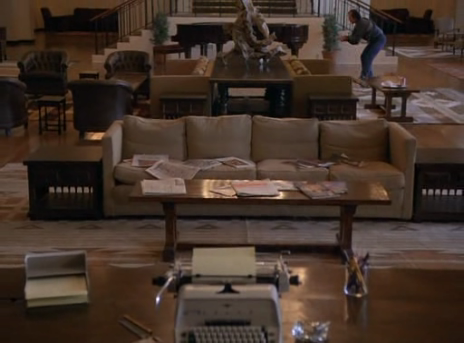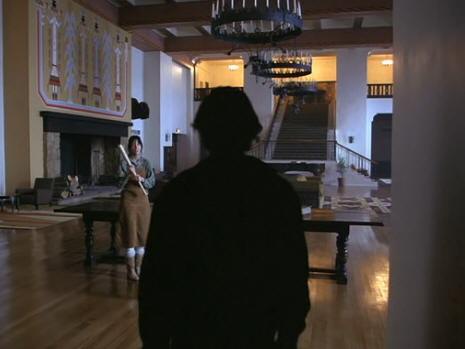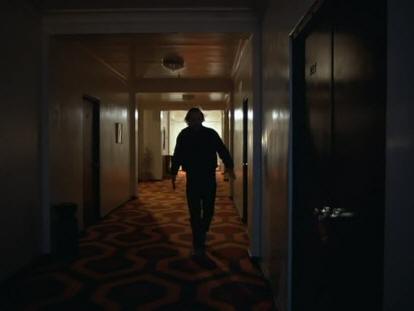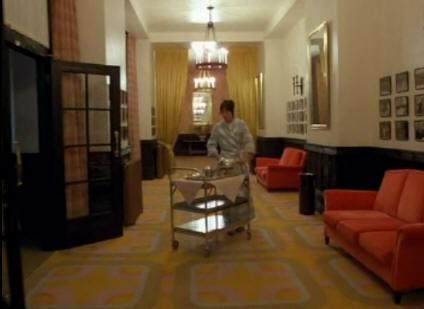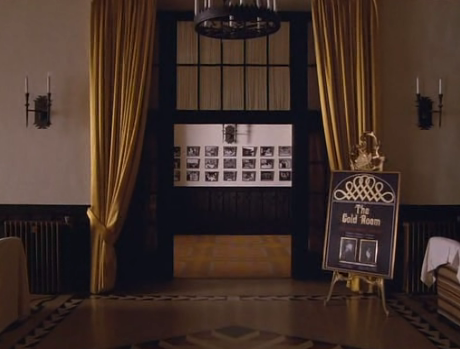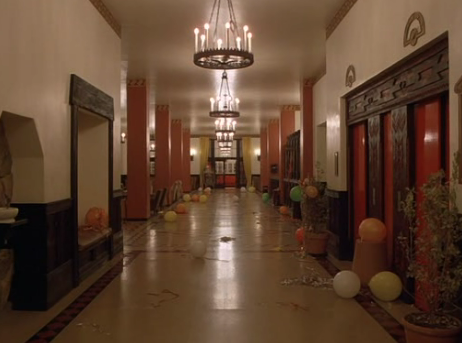CHAPTER EIGHTEEN At many points in this analysis we’ve encountered instances of The Shining’s narrative flipping back and forth between historical events and foresight of future events. The timeline of the film’s subliminal structure is mixed up in a similar way to Quentin Tarantino’s Pulp Fiction, but of course in Pulp Fiction it’s easier to unravel the chronology because the film doesn’t deceive the viewer with a false surface narrative. Fortunately, there are several mark-up devices in The Shining that can be used to categorize scenes into their appropriate place on the film’s timeframe. One of those is the use of unannounced dream sequences. Another, which we’ve partially explored, is cross symbology of characters – the rotting woman in room 237 as Jack, Halloran as a Native American. This chapter will explore a mark-up device which I’ll refer to as The Shining’s “fractal narrative”. In 2001: A Space Odyssey, the astronaut Dave Bowman made a journey through the so-called “stargate” which took him out of the two dimensional cinematic universe and into the 3-D universe of his own audience. At several points in the story we were offered subliminal indicators that we were watching a film within a film, for example the monolith was a 90 degree rotated cinema screen. The same technique is used in The Shining, but this time several scenes are presented as a film within a book … and the book in question is Jack’s manuscript. Early scenes of the film reveal that Wendy is an avid reader. The Torrance apartment in Boulder is full of stacked books. She is seen reading “Catcher in the rye” at the kitchen table as Danny eats a sandwich and in the lobby scene she is reading again. In both of these scenes Danny watches television as Wendy reads. In Jack’s interview with Ullman, he responds to the story of a previous winter caretaker murdering his family, “Well, that really is eh … quite a story”. He then assures Ullman, “Well, you can rest assured Mr Ullman, that’s not gonna happen with me and as far as my wife is concerned, I’m sure she’ll be absolutely fascinated when I tell her about it. She’s a eh … confirmed ghost story and horror film addict”. These lines are very appropriate to the film’s subliminal structure. Jack expresses writer’s block to Wendy as he eats breakfast in bed. In the scene immediately following, the camera zooms out from a blank page in Jack’s typewriter to reveal him throwing his tennis ball at the sand painting figures. Is this an indicator that Jack is writing about the slaughter of his family or the natives?
Although Kubrick shows us Jack’s manuscript in the form of endless repetitions of the same line “All work and no play makes Jack a dull boy”, one scene demonstrates that Jack was actually writing a specific story. In the scene of Wendy interrupting Jack’s writing to tell him about the weather, there is a large scrapbook open on his desk with newspaper clippings and articles pasted onto its pages. These appear to be Jack’s research materials, which would indicate he is writing about a true past event.
After Wendy leaves the room we cut back to Jack, but his scrapbook is open on a different page.
A fresh piece of paper has also magically appeared in his typewriter, even though he tore the last page out as Wendy approached him. These two details suggest that Wendy’s entrance, interruption of Jack's work and his angry response were all in Jack’s imagination. He was fleshing out a part of his manuscript. So why would Jack be writing a fictional argument with his wife? Because Ullman planted the idea in his mind to write a horror novel based upon the real life case of Charles Grady killing his family. As he told Ullman, “That really is eh … quite a story”. This also explains why he says his “confirmed ghost story and horror addict” wife will be fascinated about the Grady case. He is intending to tell her about the case through his fiction novel. Rather than being possessed by some evil force in the hotel, Jack’s murderous insanity is brought on by him writing about the Grady case, with himself in the lead role. He writes himself into insanity. During his first conversation with Delbert Grady, Jack reveals, “I saw your picture in the newspaper. You eh … chopped your wife and daughter up into little bits and then you eh … then you blew your brains out”. This is why he had a nightmare of chopping his own wife and son “into little pieces”. He has been reading newspaper clippings about the original case and rewriting the story in novel form. A very bizarre shot is when Danny’s neck scars are revealed to Wendy in the Colorado Lounge. A shot over Jack’s shoulder shows Wendy and Danny positioned directly above the typewriter, as if they are part of his writing.
Perhaps this is another indicator of Jack’s confusion between reality and his fictional imagination. The scenes of Halloran making phone calls to the KDK 1 station and then making his way (via plane, car and snowcat) to the Overlook feature a variety of details that suggest they are also manifestations of Jack’s writing. The first thing to note is the almost deliberately lame dialogue. There’s too much narrative exposition, the typical sign of a bad writer. The scenes are incredibly basic and lack the edginess that characterizes the rest of the film. The acting is also clunky, as if Kubrick was deliberately under-directing his cast. And Halloran appears far too relaxed considering that in the surface narrative he shared Danny’s horrific vision of the woman in room 237. The prop and set arrangements of Halloran’s travelling scenes offer more clues that the scenes are manifested in Jack’s imagination at his typewriter. As Halloran drives through snow in his car, he passes an overturned truck and underneath the truck is a crushed red Volkswagon. Jack originally drove a yellow Volkswagon to the overlook.
A Westminster Boulder sign is also seen from Halloran’s car. The Torrance’s had travelled from Boulder.
A black and white magazine cover on the desk in Durkin’s garage bares resemblance to the black and white photos featured on the Gold Room entrance sign.
Also in Durkin’s garage is a picture of cartoon pig characters being chased by ghosts. Jack later calls his family “little pigs”.
A man near the entrance to Durkin’s garage is looking at a soft porn calendar.
Remember that we saw one of these on Jack’s bathroom door in the making of documentary.
Overall these are very boring scenes and in the surface narrative serve no more purpose than to simply drive the plot forward, but in the subliminal narrative they reveal Jack’s talentless writing skills. Notice that in the middle of Halloran’s journey Kubrick dissolves to a shot of Jack writing in the Colorado Lounge for a few seconds and then back to Halloran’s plane landing (US DVD version). We are watching Jack’s manuscript content as he writes it. Another example of this seemingly poor writing by Jack is that we are shown three incredibly boring scenes of Halloran making phone calls from his apartment as he tries to reach the Torrance’s. In all three scenes Halloran paces back and forth in the same manner as if Jack is rewriting the same scene. Once again we have lame dialogue and minimal acting. This process of Jack rewriting history effectively causes the Grady tragedy to repeat itself in the Overlook, but the time loop goes back further. The scenes of Jack entering the Gold Room to chat with Lloyd and Grady contain some very consistent details relating to a shift of time. Jack talks to a Delbert Grady, but Ullman said it was Charles Grady who killed his family with an axe. Another clue is that Jack is only referred to by his surname and although he talks about his family he doesn’t use their names at all. Jack at the bar: “Just a little problem with the old sperm bank upstairs … I never laid a hand on him goddamn it … I wouldn’t touch one hair on his goddamn little head … I love the little son of a bitch … I’d do anything for him, any fuckin’ thing for him … I did hurt him once ok … The little fucker had thrown all my papers all over the floor. All I tried to do was pull him up!” Why all the inconsistency with names? Because in the Gold Room we are watching a different generation of the Grady and Torrance bloodlines. Delbert Grady was the father of Charles Grady and both of them murdered their families. Likewise, the “Mr Torrance” who we watch in the Gold Room isn’t Jack. He’s Jack’s father. That’s why his descriptions of his wife and son don’t include their first names. And that’s why we see a Jack Torrance look-alike in the framed picture at the end of the film. The time mismatches relating to Jack’s abuse of his son also fit with this multi-generation interpretation. Jack hadn’t drank for five months after injuring Danny’s arm, but the Mr Torrance in the Gold Room tells us that he injured his son “Three goddamn years ago”. There's a cycle of abuse in the family. Danny was injured by Jack for scattering his writing papers across the floor and the same thing was done to Jack by his father. Danny is sexually abused by Jack in the fatherly love scene and again Jack suffered the same abuse in his childhood (the bear felatio scene). Another hint is that Jack is referred to as a “son of a bitch” by his wife and his father. Wendy after seeing Danny’s injuries, “You did this to him. You son of a bitch!” Torrance Snr at the Gold Room bar, “I wouldn’t touch one hair on his goddamn little head. I love the little son of a bitch!” Perhaps this also sheds light on the film’s hints of never-ending cycles. Grady’s cryptic lavatory dialogue, “You are the caretaker. You’ve always been the caretaker”. The twin girls, “Come and play with us Danny … forever … and ever”. The Grady and Torrance families are trapped in cycles of abuse. Remember that Jack symbolically stepped out of a photograph behind Wendy while she was reading his manuscript.
His presence as a ghostly shadow can also be found in other picture props in the hotel. The two best examples being the wall picture just inside the room 237 doorway ...
... and the picture next to the map of Colorado in Ullman’s office – here the shadow figure is visible when Jack is sabotaging the radio.
Jack was also seen in silhouette form after leaving room 237.
So the hidden narrative of The Shining is quite complex. Some scenes show a prior generation Mr Torrance hanging out in the Gold Room. Other scenes are manifestations of Jack’s imagination as he types his manuscript. And yet more scenes are dream sequences. And … there is still more to unravel. An important question is, “Are any of the other scenes of the film set in the past?” To answer this we must first make some storyline adjustments based upon what we’ve already decoded. If the scenes of Halloran travelling to the Overlook are part of Jack’s manuscript then how does the real Halloran end up being killed in the Lobby? In a way we’ve already answered this riddle. Halloran represents the natives who were slaughtered in genocide, so his murder can be considered an echo of a past event. It’s interesting that as Wendy creeps down a hall to see Halloran’s body the lights above her are off, but after seeing the body she spins to see the party guest and the lights are on.
Another odd detail in this scene is that an ornamental piece of Driftwood on a table (beneath the seven diamonds wall tapestry) disappears immediately after we see Halloran’s body. And then of course there’re the disappearing wall pictures.
Perhaps this collection of continuity mismatches is communicating another time shift. The switching on of the lights could also be a continuation of the film’s conspiratorial messages related to falsely enlightened secret society members. Shortly after Wendy sees Halloran’s body she re-enters the Lobby from a different direction. All the lights are off, the room is full of skeleton party guests and Halloran’s body is gone. The hallway through which she runs in the build up to seeing the skeletons is a peculiar piece of set design. She runs directly from a dead end wall that has a table beneath it.
In other scenes of this hallway, when it is more lit, there is a mirror on the dead end wall. This mirror is, for some reason, missing in the skeleton scene.
It’s possible that these assorted details such as missing mirrors and missing dead bodies are again related to time shifts in the subliminal narrative. We may even be seeing the wife of Jack’s father (or even a more distant relative) in the skeleton scene, rather than Wendy. The gash on the party guest's head links him symbolically to Jack and the camera directly gives chase to Wendy as if the ghost is running after her. Is this the wife of a former caretaker being pursued to her death? An important narrative change is that if it’s Jack’s father who talks to Delbert Grady in the lavatory then the young boy, whose behaviour they discuss, would be Jack himself. Did young Jack try to rebel against his father by bringing “an outside party into this situation?” And what exactly was the “very great talent” that Jack had as a child? Did he show some early promise as a writer? Could it even be that he attempted to write about the genocide of the natives, the “outside party” being the slaughter of Halloran in the lobby? Whatever the answers to these questions, it seems that young Jack in some way rebelled against his father and was “corrected” for doing so? In other words he was beaten, abused and traumatized, hence he grows to become like his father, even appearing exactly like him. Another possible time and narrative shift may occur as Wendy reads Jack’s manuscript. This is a sketchy idea but I’ll put it on the table anyway. The battle between Wendy and Jack in the Colorado Lounge could actually be what Wendy is reading about in the manuscript – Jack’s fictionalized version of the past. The prioritizing of personal writing over the well-being of the family unit is a generational recurrence. Young Jack, Wendy and Danny are viewed as traitors when they attempt to investigate the work papers of the man in the family. All these family men seem to require absolute secrecy in what they write, as if struggling from one generation to the next to keep the lid on the atrocities they have committed. The final shot of the lobby, with the shot dollying into a photo of Jack, is probably happening in a different time zone to Halloran’s death. Wendy and Danny left the hotel in a hurry and so the lights in the lobby should still be on.
Not only have they been mysteriously been switched off, but the chairs are draped in white sheets.
And the Gold Room sign has also moved to the right side of the doors, but it was on the left side when Halloran was killed.
It was also on the right side of the doors at the beginning of the film when Jack came for his interview.
So it seems likely that all of the lobby scenes in the second half of the film, which feature the Gold Room sign to the left of the doors and no sheets over the furniture, were set in the past and that the final shot is more likely in the present or future. For some reason the forward motion of the final shot also suggests a continuation of Jack’s forward moving view of the lobby, in which we saw balloons and party confetti.
Apparently in the deleted ending scene, Ullman explains to Wendy in the hospital that her visions of ghosts in the Overlook were simply hallucinations. This was another standard device of Kubrick’s – a character explains the hidden narrative in simple verbal terms, but the deceptive surface narrative prevents us from believing it. The concepts in this chapter are incomplete in terms of the explanations I’ve offered. There are several loose ends, but there is undoubtedly a pattern of historical repetition in The Shining. The hidden narrative jumps back and forth between different generations of the Torrance family. In this chapter we explored how Nicholson played both Jack Torrance and the father of Jack Torrance, who we can only refer to as “Mr Torrance”, and how these men each repeat the mistakes of the previous generation. A simple metaphor of this cycle of abuse is communicated in several of the long distance shots of the Overlook scattered throughout the movie, in which we hear owl-like sounds. Are these the screams of women and children being murdered in the Overlook? The Shining, however, is also the story of how this cycle of abuse is finally broken. To understand how this occurs we must turn our attention to the multiple manifestations of Danny Torrance.
|
